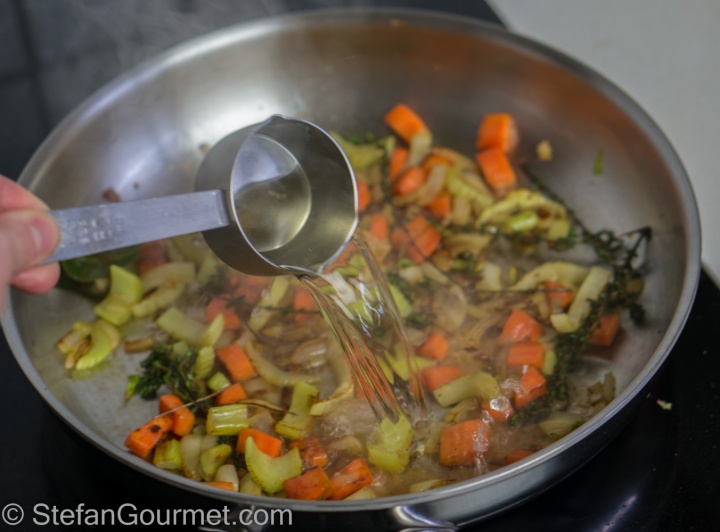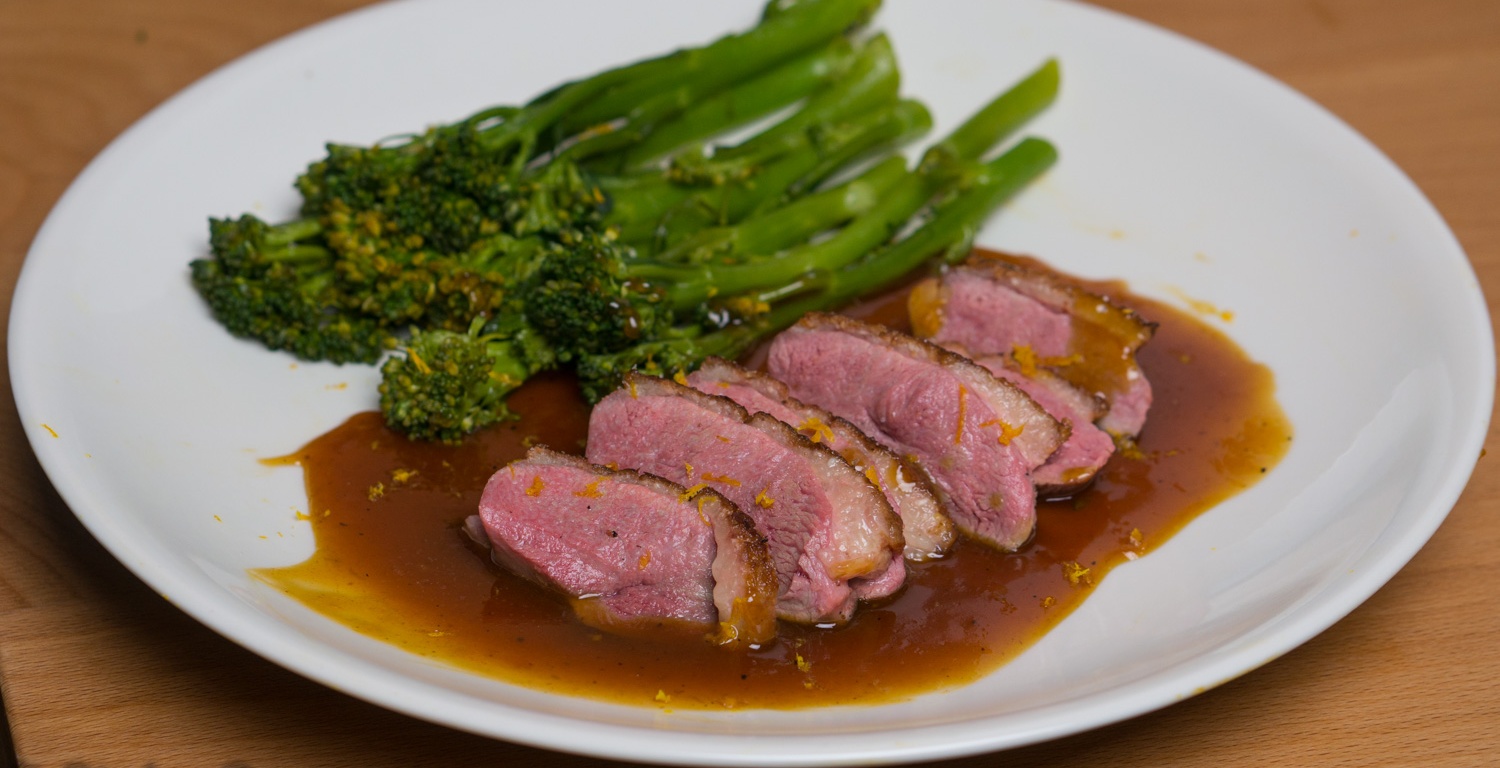
Canard à l’Orange is a French classic that I hadn’t cooked in a while. It can be prepared either with a whole duck or with duck breast, as I did here. Duck breast is called magret de canard (magret because it is, relatively speaking, the lean (magre) part of the duck). The orange sauce is made with freshly squeezed orange juice, white wine, duck stock (or chicken stock), caramelized sugar, Grand Marnier, orange zest, and vinegar, and has a great depth of flavor with all five flavor components present (sour, sweet, bitter, salt, and umami). It is important for this recipe to obtain a good balance between these five flavors. The meat and sauce pair very well with steamed broccoli or broccoli or broccolini. If you like you can add orange supremes to the sauce, but here I omitted them. For best results cook the duck breast sous-vide, but by finishing it in the oven you can also get excellent results. Here’s what I did…
Ingredients

For 2 small or 4 large servings
1 whole duck breast, about 400 grams (.9 lbs), skin on
250 ml (1 cup) freshly squeezed orange juice
125 ml (1/2 cup) duck stock or chicken stock
grated zest of 1/2 orange
orange supremes (optional)
75 grams (6 Tbsp) sugar
80 ml (1/3 cup) white wine
30 ml (2 Tbsp) white wine vinegar
30 ml (2 Tbsp) Grand Marnier (orange liqueur)
50 grams chopped carrot (1/2 cup)
50 grams chopped onion (1/2 cup)
50 grams chopped celery (1/2 cup)
1 bay leaf
some sprigs fresh thyme
salt and freshly ground black pepper
1 Tbsp corn starch
400 grams (.9 lbs) broccoli or broccolini
Preparation

Score the skin of the duck breasts in a diamond pattern, making sure to cut only the skin and not the meat underneath. This helps to render the fat from the skin.

Season the duck with salt and freshly ground black pepper on the meat side, and put it skin side down in a frying pan over high heat.

Allow some of the fat to render over high heat until the skin is golden brown, about 3 minutes. Then turn over and cook on the meat side for another minute. Turn off the heat.

Take the meat out of the pan. When cooking the meat sous-vide, allow to cool to refrigerator temperature. Then vacuum seal and cook sous-vide for at least 2 hours or up to 6 hours at 57ºC/135ºF.
When cooking in the oven, insert a meat thermometer and cook in the oven at 120ºC/250ºF until an instant read meat thermometer inserted with the tip in the center reads 55ºC/131ºF (because the core temperature will continue to increase once you take the meat out of the oven).

Add the carrot, onion, cerlery, thyme, and bay leaf to the frying pan with the duck fat and sauté over medium heat until golden (about 5 minutes).

Deglaze with the white wine, scraping with a wooden spatula to get all the browned bits.

…and the duck stock or chicken stock.

Cook over medium heat until reduced by about half.

Add the juices that by now have leaked from the duck breast as well. Season with salt and freshly ground black pepper.

Zest one of the oranges before squeezing them for juice.

Put the sugar in a saucepan with just enough water to let the sugar ‘melt’.

Cook over high heat until you obtain a caramel. Make sure you have the vinegar and orange juice handy once the caramel starts to turn amber, because it goes from amber to black much more quickly than from transparent to amber.

Wait until the caramel is dark brown but not black, then add the vinegar…

Cook this over medium heat until reduced by half.

Add part of the reduced orange juice to the reduced stock. Do not add everything at once, but taste to find the right balance. If you add too much, the sauce may become too sweet. You may also need to add salt and freshly ground black pepper to taste.

Bring the sauce to a boil, then dissolve a tablespoon of corn starch in cold water and add this slurry to the sauce.

Cook over medium heat for a minute, stirring, until the sauce thickens. Keep warm over low heat.

If you timed everything perfectly, the meat should now be cooked (either sous-vide or in the oven). Add any juices that leaked from the meat to the sauce.

When you cooked the meat sous-vide, it is nice to heat it up slightly on the outside in a non-stick frying pan over high heat. 30 seconds per side is enough.

The broccoli(ni) should also be steamed by now, about 8 minutes or until tender but still firm to the bite.

Slice the duck and serve it with the sauce and broccoli(ni) on preheated plates.
Wine pairing
Although duck breast is red meat and usually served with a red wine, in this case because of the sauce an usual but great choice is a late-harvest (Vendanges Tardives) Gewurztraminer from Alsace. The sweet, sour, and bitter of the wine are a great pairing with the sauce. Dry reds or whites would not work with the sauce.
Flashback

All the recipes I could find for lobster risotto did not use the lobster shells to make lobster stock to use for the risotto. They were simply a plain risotto with a lobster served on top. And so I decided to create my own recipe for lobster risotto and it turned out spectacular! This risotto is served with the lobster tail on top, delicious lobster meat mixed in with the rice that has a wonderful lobster flavor from the stock, as well as peas, tomato, and yellow bell pepper for lovely colors. This dish has a nice contrast between the creamy rice and crunchy vegetables.





This looks absolutely wonderful! I love duck cooked sous vide!
LikeLiked by 1 person
A fabulous duck dish.
LikeLiked by 1 person
Questo piatto deve essere una vera delizia. Mi ricorda tantissimo il mio anno trascorso a Londra dove lo chef dell’albergo dove lavorava ci presentava spesso un succulento “duck””. Have a nice evening Bea
LikeLiked by 1 person
Lovely method indeed Stefan. The sauce must have been delicious.
LikeLiked by 1 person
Quanto tempo che non preparo il petto d’anatra! E poi una ricetta senza sottovuoto ❤ 😀
LikeLiked by 1 person
Oh my, this looks fantastic! Well done, Stefan!
LikeLiked by 1 person
I made this recipe last sunday and it was really good and came out perfect.
LikeLike
That is great to hear! Thanks for letting me know.
LikeLike